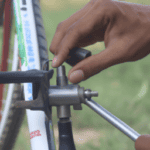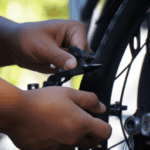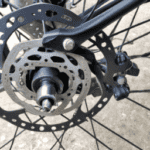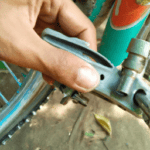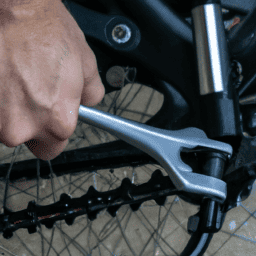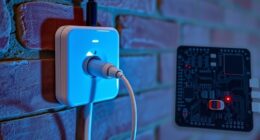Learning how to fine-tune your bicycle’s brakes is a vital ability for cyclists of all levels. It doesn’t matter if you ride professionally or just for fun, having brakes that work well is imperative to keep you safe while cycling. In this article, I’ll walk you through the detailed process of tweaking your brakes to ensure they’re working at their best.
Before we get started, it’s important to note that there are several types of brakes that can be found on bicycles, including rim brakes, disc brakes, and coaster brakes. In this article, we will focus on adjusting rim brakes, which are the most common type of brake found on bicycles.
With the right tools and a little bit of patience, adjusting your rim brakes is a straightforward process that can be done at home. So let’s get started!
Key Takeaways
- Adjusting brakes is crucial for safety while cycling
- Regular inspection and maintenance of brakes is necessary
- Basic tools like wrench, screwdriver, and pliers are needed for adjusting brakes
- Fine-tuning brakes may take time, but it is important for optimal performance and safety
Gather the Necessary Tools
Gather the necessary tools.
You’ll need some basic tools to get started, like a wrench, screwdriver, and pliers. Choosing appropriate tools is crucial to successfully adjusting your bike brakes. For instance, a wrench is necessary to loosen bolts, while a screwdriver is used to adjust the brake pads. Pliers come in handy when you need to make small tweaks to the brake cables.
Importance of proper maintenance cannot be emphasized enough. If your tools are worn out or rusty, they may not function properly and can potentially damage your bike. It’s important to keep your tools clean and lubricated, and replace them when necessary.
With the right tools and proper maintenance, you’ll be ready to inspect your brakes and make necessary adjustments.
Inspect Your Brakes
Before starting your ride, take a moment to check that your stopping mechanism is in good working order.
Inspect your brakes by first examining the brake pads. Check that they’re not worn down or damaged. If the pads are worn down, replace them immediately. Also, make sure that the pads are aligned with the rim. Misaligned pads can cause poor braking performance or even damage the wheel.
Next, check the brake cables and housing. Look for any fraying or kinks in the cable and ensure that the housing isn’t cracked or split. Common issues with brake cables include rust and dirt buildup, which can cause the brakes to stick or become less responsive. Troubleshooting these issues might involve cleaning or lubricating the cables, or replacing them altogether.
Remember, regular brake inspection is crucial for safe cycling, so make sure to inspect your brakes before each ride.
Now that you’ve inspected your brakes and identified any issues, it’s time to adjust them for optimal performance.
Adjust Your Brakes
Now that you’ve given your bike’s stopping power a thorough inspection, it’s time to fine-tune your braking system for peak performance. Here’s how you can adjust your bike’s brakes:
-
Loosen the brake cable anchor bolt: Start by loosening the cable anchor bolt on your brake caliper. This will allow you to adjust the cable tension.
-
Adjust the cable tension: Pull the brake cable tight by squeezing the brake lever and then re-tighten the cable anchor bolt. Make sure the brake pads are centered and that the gap between the pads and rim is even on both sides. If not, adjust the position of the brake pads by loosening the brake pad fixing bolt and sliding the pad up or down until it’s in the right position.
-
Check the brake lever position: Make sure the brake lever sits parallel to the handlebar when you’re not squeezing it. If it’s not, adjust the position of the brake lever by loosening the brake lever clamp bolt and sliding the lever up or down until it’s in the right position.
-
Test your brakes: Before you hit the road, give your brakes a test run. Make sure the brakes engage smoothly and that the pads don’t rub against the rim when you’re not braking. If your brakes aren’t working properly, refer to the troubleshooting tips below.
Common mistakes when adjusting your brakes include adjusting the brakes too tight, which can cause the brakes to rub against the rim even when you’re not braking, and not adjusting the brake pads so that they’re centered and even. If you’re having trouble adjusting your brakes, try these troubleshooting tips:
-
Make sure there’s no dirt or debris on the brake pads or rim that could be causing the brakes to slip or not engage properly.
-
Check the cable tension and adjust it as necessary.
-
If your brakes are still not working properly, consider replacing the brake pads or cables.
Now that your brakes are adjusted, it’s time to test them out on the road to make sure they’re working properly.
Test Your Brakes
As you glide down the hill, feeling the wind rushing past you, it’s important to know that your brakes can handle the pressure. Before you hit the road, it’s crucial to test your brakes to ensure they’re working correctly.
Start by inspecting cables for any signs of wear and tear. Check for frayed or kinked cables, as these can cause your brakes to malfunction. If you notice any issues, replace the cables immediately.
Next, troubleshoot any issues you may encounter. If your brakes feel spongy or unresponsive, it could be due to air in the brake lines. Bleed the brakes to remove any air bubbles and restore proper function. If your brakes are rubbing against the wheel, adjust the brake pads to ensure they’re centered and not touching the rim.
Once you’ve inspected and troubleshooted any issues, you can move on to fine-tuning your brakes for optimal performance. Fine-tune your brakes by adjusting the tension on the brake cables and pads. This will allow you to control the amount of pressure needed to stop your bike.
With properly adjusted brakes, you can confidently tackle any terrain and enjoy a safe and smooth ride.
Fine-Tune Your Brakes
Now that I’ve adjusted my brakes, it’s time to fine-tune them.
I’ll begin by making minor adjustments to my brake pads.
Then, I’ll repeat steps 3 and 4 from the previous subtopic until I’m satisfied with my brakes’ performance.
This process may take some time, but it’s crucial to ensure my brakes work correctly and keep me safe while riding.
Make Minor Adjustments
Fine-tuning your brakes is a breeze, just take a look at the pads and squeeze the brake lever to make sure they’re aligned, and adjust accordingly. However, if the brakes are still not responsive, then it’s time to make minor adjustments. Here are some steps to follow for making those adjustments:
| Step | Action | Purpose | Result |
|---|---|---|---|
| 1 | Loosen the brake cable pinch bolt | To allow for cable adjustment | Cable can be adjusted |
| 2 | Tighten the brake cable adjusting barrel | To increase tension on the cable | Brake pads move closer to the rim |
| 3 | Test the brake lever | To check responsiveness | Brake lever feels firmer |
| 4 | Retighten the brake cable pinch bolt | To secure cable in place | Cable stays in adjusted position |
Repeat steps 3 and 4 until satisfied with the brake responsiveness. It’s important to remember that proper installation and maintenance of brake pads and cables is crucial for optimal performance. By following these steps and ensuring proper maintenance, your brakes will be in top shape for your next ride.
If the brakes are still not responding after making minor adjustments, it may be time to replace the brake pads or cables altogether. In the next section, we’ll discuss how to perform those replacements.
Repeat Steps 3 and 4 Until Satisfied
Keep testing the brake lever and retightening the cable pinch bolt until you’re satisfied with the responsiveness, ensuring your bike is safe for your next adventure. It may take a few rounds of adjustments to get the brakes feeling just right, so practice patience and take your time.
If you encounter any issues during the process, don’t panic. Troubleshoot the problem by checking the cable tension, brake pads, and positioning of the brake arm. As you make adjustments, pay attention to the feel of the brake lever and the stopping power of the brakes.
Are they too loose or too tight? Do they stop the bike quickly or take too long to engage? Keep making small adjustments until everything feels just right.
Remember, a well-adjusted set of brakes can make all the difference in your ride, so take the time to get it right.
Repeat steps 3 and 4 until satisfied.
Frequently Asked Questions
How often should I adjust my bicycle brakes?
Based on frequency recommendations and best practices, I adjust my bicycle brakes every 1,000 miles or when I notice decreased braking performance. Regular maintenance is crucial to ensure safe and efficient stopping power.
What kind of brake pads should I use for my bicycle?
When it comes to choosing bicycle brake pads, it’s important to consider both performance and longevity. Different materials, such as organic and metallic, have their pros and cons. Factors to consider include your type of cycling and personal preference.
How do I know if my brake cables need to be replaced?
To determine if your brake cables need replacing, look for signs of worn cables such as fraying or visible rust. Replacing brake cables at home requires the right tools and knowledge of proper installation techniques.
Can I adjust my brakes if I don’t have the necessary tools?
Adjusting brakes without proper tools is like trying to write with a broken pencil. Brake adjustment alternatives include using pliers or a wrench to adjust cable tension. DIY brake tuning requires patience and attention to detail to ensure proper function.
Are there any safety precautions I should take while adjusting my brakes?
When adjusting brakes on a bicycle, it is important to take safety measures such as wearing gloves and eye protection. Additionally, the necessary tools needed include a wrench, screwdriver, and cable cutters.
Conclusion
Well, folks, that concludes our guide on how to adjust brakes on a bicycle. I hope you found this information helpful, but let’s be honest, who needs functioning brakes anyways? It’s not like they’re crucial for stopping or anything.
Sure, you could take the time to inspect and adjust your brakes properly, but why bother? Just live on the edge and embrace the thrill of potentially crashing into a tree or running over a small animal. Who needs safety when you have adrenaline?
So go ahead, skip this guide and ride your bike with reckless abandon. Just don’t say I didn’t warn you.


